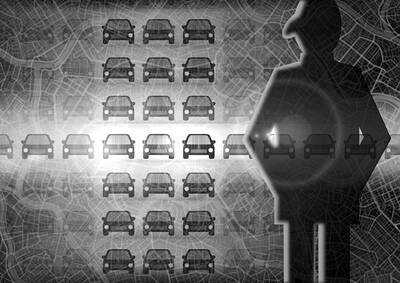This year has definitely not been a lucky one for Taiwan Power Co (Taipower). The utility company is facing a deteriorating financial situation, and Japan’s nuclear crisis — which has raised public worries about nuclear safety and may force the government to delay the commercial operation of the Fourth Nuclear Power Plant for another year — only adds a further blow.
Moreover, the decision by two international ratings agencies on Friday to downgrade the credit rating of Tokyo Electric Power Co (TEPCO), which operates the troubled Fukushima Dai-ichi nuclear power plant, has not only made TEPCO the first Japanese power company to face the possibility of defaulting on its debt, but also exposed a potential risk for Taipower in terms of operational reliability and the potentially massive costs involved in the event of a catastrophe.
For some time people have held concerns about Taipower’s ability to handle a major nuclear accident like the one occurring at the Fukushima plant. Unfortunately, they have not paid much attention to the company’s financial problems.
Last year, Taipower incurred a loss of NT$18.7 billion (US$631.8 million), which was its third--largest deficit in the past 10 years. In 2008, the company had a record loss of NT$100.9 billion. The company has also warned that its deficit could reach NT$60 billion this year, owing to skyrocketing fuel costs. As a result, accumulated losses are likely to total NT$135.1 billion at the end of this year, a figure that represents 40.94 percent of Taipower’s paid-in capital.
Utility companies around the world need continued cash flow and efficient access to financial tools to maintain operations and build facilities. Taipower has long relied on bank loans and corporate bond issuance to raise capital. Actually, the company is the largest issuer of corporate bonds in Taiwan, accounting for 16 percent of the total, and the yield on its bonds usually serves as a benchmark for the country’s corporate bond market. Last year, the company issued NT$89.2 billion in corporate bonds, following NT$58.62 billion issued in 2009.
Ironically, despite Taipower’s weakening financial profile over the past few years because of a -government-initiated cap on electricity rates, its corporate bonds have been warmly received by investors as the debt issues have a very low default risk. This is because Taipower is a government-owned utility and investors believe the company’s triple-A-rated bonds have the same value as the government bonds do.
However, the company’s deteriorating financial situation is a time bomb. When issuing corporate bonds, the company now needs a third-party guarantor to provide a guarantee or partial guarantee over the proposed debt issues, as required under the nation’s corporate law.
Furthermore, if the company’s accumulated losses exceed 50 percent of its paid-in capital, Taipower would, by law, have to request permission from shareholders to increase capital or be forced to close down operations.
This raises the question of where the cash injection would come from. One option is to increase electricity rates to help cut losses. While this is theoretically reasonable, it would likely be political suicide in an election year, and amid inflationary concerns. Barring changes in current electricity rates, an alternative is to ask the government to inject more capital into the company, but this seems equally unfeasible in light of the government’s growing debt.
Privatization, deregulation and cost-cutting reforms would be other options to help Taipower turn around its dire financial situation, but one way or another, Taipower’s financial problem needs to be taken seriously. If not addressed, the state-run utility’s widening losses will only add to existing public-sector debt and impose a burden on future generations of taxpayers.
Concerns that the US might abandon Taiwan are often overstated. While US President Donald Trump’s handling of Ukraine raised unease in Taiwan, it is crucial to recognize that Taiwan is not Ukraine. Under Trump, the US views Ukraine largely as a European problem, whereas the Indo-Pacific region remains its primary geopolitical focus. Taipei holds immense strategic value for Washington and is unlikely to be treated as a bargaining chip in US-China relations. Trump’s vision of “making America great again” would be directly undermined by any move to abandon Taiwan. Despite the rhetoric of “America First,” the Trump administration understands the necessity of

US President Donald Trump’s challenge to domestic American economic-political priorities, and abroad to the global balance of power, are not a threat to the security of Taiwan. Trump’s success can go far to contain the real threat — the Chinese Communist Party’s (CCP) surge to hegemony — while offering expanded defensive opportunities for Taiwan. In a stunning affirmation of the CCP policy of “forceful reunification,” an obscene euphemism for the invasion of Taiwan and the destruction of its democracy, on March 13, 2024, the People’s Liberation Army’s (PLA) used Chinese social media platforms to show the first-time linkage of three new

If you had a vision of the future where China did not dominate the global car industry, you can kiss those dreams goodbye. That is because US President Donald Trump’s promised 25 percent tariff on auto imports takes an ax to the only bits of the emerging electric vehicle (EV) supply chain that are not already dominated by Beijing. The biggest losers when the levies take effect this week would be Japan and South Korea. They account for one-third of the cars imported into the US, and as much as two-thirds of those imported from outside North America. (Mexico and Canada, while
The military is conducting its annual Han Kuang exercises in phases. The minister of national defense recently said that this year’s scenarios would simulate defending the nation against possible actions the Chinese People’s Liberation Army (PLA) might take in an invasion of Taiwan, making the threat of a speculated Chinese invasion in 2027 a heated agenda item again. That year, also referred to as the “Davidson window,” is named after then-US Indo-Pacific Command Admiral Philip Davidson, who in 2021 warned that Chinese President Xi Jinping (習近平) had instructed the PLA to be ready to invade Taiwan by 2027. Xi in 2017